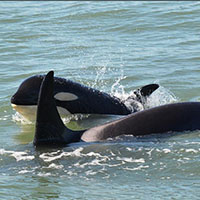— by Margie Doyle —
Toby Cooper, who at the last EPRC meeting issued a call for immediate action on behalf of the Southern Resident Killer Whales (SRKW) who face extinction (orcasissues.com/eprc-considers-a-plea-for-our-orcas/), spoke in advance of EPRC Co-Chair Margaret Payne’s report on actions that could be taken. Cooper said the report is a “public expression of solidarity with the whales. It is heartfelt; its real power is tremendous.
“What we’re doing here is one of the first times someone has set up definitive targeted action to do something to benefit the whales.” Cooper spoke of the year-long efforts of the EPRC-led Eastsound Visioning Process and the survey taken by 388 people, taking the entire survey and many more taking parts of the survey: “Implement protections for Fishing Bay and Ship Bay” were ranked in the top three of the proposed actions in the survey (eastsoundvision.com)
Cooper submitted four documents that reflect local actions on the crisis for the EPRC meeting record:
- A letter to Canada’s Prime Minister Trudeau from the County Council “taking Trudeau to the woodshed about the trans-mountain pipeline tied to the whales’ survival; “Is this our new reality — summers of dying whales and unbreathable air? We object to Trans-mountain [pipeline] because the environmental and economic costs are too high.” Cooper commended Hughes and the Council for their “good work” in responding to the Canadian government’s decision.
- “Long Live the Kings” annual meeting where Civil Engineer Jim Waddell of https://damsense.org/ talked of breaching dams on Snake River, to protect salmon fry moving to the ocean. A letter was sent to Governor Inslee’s SRKW Task Force, signed by 33 Ph.D. salmon biologists in support of breaching the four Snake River dams.
- Article by Bob Friel in Outside magazine, a personal account of the undernourished whale Scarlett and the implications of the plight of the whales. “We declare [them] national and regional treasures, yet we … kill them.”
- A photograph of local eelgrass beds with improperly configured buoys destroying the beds, which are necessary in the food chain of chinook salmon and whales.
Tina Whitman of Friends of the San Juans said that the Governor’s SRKW task force (governor.wa.gov/issues/issues/energy-environment/southern-resident-killer-whale-recovery-and-task-force) will give its draft report on Sept. 25 with public comment due in early October, and she encouraged individual to comment. The Task Force is co-chaired by Orcas Island resident Stephanie Solien and Les Purce; County Councilman Jamie Stephens and Public Works staff Kendra Smith both serve on the Task Force.
Later in the meeting Co-Chair Margaret Payne read the three-page report prepared as promised by the Open Space Committee of the EPRC, to propose efforts to respond to the SRKW crisis, “The Open Spaces Visioning Group report regarding protection of the nearshore waters of Fishing Bay and Ship Bay.” Due to technical difficulties beyond county control, the report was not sent to the EPRC members before the meeting. The report is copied here: NearShoreWaters_090818
The report outlined 10 actions to take, and Payne said, “It’s going to take a lot of efforts and changes. We have a unique opportunity in Eastsound to do a very important piece.”
Those protective actions are:
- Encourage boaters to respect the existing, voluntary no-anchor zone and to expand the zone to protect all eelgrass in the herring spawning areas [by enumerated actions]
- Install permanent mooring buoys (maximum 6) in Fishing Bay beyond the no-anchor zones to aid in the reduction of anchoring impacts while supporting safe moorage
- Establish a permanent moratorium on new anchoring buoys within the no-anchor zone
- [Limit] in-and-over-water development along the shorelines
- Maintain the County dock at Madrona Pt as a dinghy dock …
- Use a “herring lens” to identify and prioritize a “top-three stormwater-management projects to protect water quality in the eelgrass meadows…
- Promote the Washington State “open-open space” tax break (“public-benefit rating system”) to protect critical shorelines and assist interested property owners to enroll.
- Partner with the San Juan County Marine Resources Committee and other partner organizations to identify positive actions to protect herring spawning grounds….
- Enact a public education program to inform Orcas Island residents (adult and school-age) and visitors to the islands of the critical value of the eelgrass meadows of Fishing and Ship Bays to the survival of Chinook salmon and Orca whales
- Uphold steps 1-9 above as a model for protection of remaining eelgrass meadows, herring spawning habitats and marine shorelines….
However, because of the extensive agenda at the Sept. meeting, and because the EPRC had not read the report previous to the meeting, it was decided to continue the matter to October’s meeting.
**If you are reading theOrcasonian for free, thank your fellow islanders. If you would like to support theOrcasonian CLICK HERE to set your modestly-priced, voluntary subscription. Otherwise, no worries; we’re happy to share with you.**








Hurray for the Open Space Visioning group!
Please read their report: NearShoreWaters_090818
that is an active link in the article above. Island residents, and especially boaters and shoreline property owners have the power to help the salmon and orca whales that are struggling with shrinking food supplies. Our wild island shorelines are essential to the survival of young Chinook salmon that need shelter and abundant food so that they can quickly grow and increase their odds of survival and return as adult salmon. Thank-you to shoreline property owners who protect their wild shorelines. Thank-you to those who support restoration of degraded shorelines. The survival of orca and salmon depends on wild shorelines where eelgrass and kelp capture the energy of our sun and provide shelter for young salmon.